This recipe uses the Amish Friendship Bread Potato Flake Starter variation.
I’m a sucker for sourdough bread straight out of the oven. This recipe yielded one loaf plus a second pan with 12 rolls. They say it’s best to let it cool, but what’s the fun in that? I eat it fresh out of the oven with a generous slab of butter. Yum!
Using a stand mixer with a dough hook or in a large bowl, add 1 cup Amish Friendship Bread Potato Flake Starter, 6 cups bread flour, 1 tablespoon salt, ½ cup sugar, ½ cup oil, and 1¼ cups warm water.
Mix for 5 to 10 minutes or until dough is smooth and elastic.
I use butter wrappers to grease my mixing bowls and pans–save them in the freezer every time you use up a stick of butter!
Place dough ball in greased bowl and cover with a damp dish towel. Place in a draft-free place to rise overnight (at least 12 hours).
Punch down the dough and turn onto a floured surface. Knead for a few minutes to remove an air bubbles.
Grease two loaf pans. I used one loaf pan and my copper baking pan that has removable dividers so I can make four mini loaves, 12 buns, or one cake. I opted for the buns.
Divide the dough evenly between the pans and shape the dough so it reaches the sides. Loosely cover and let rise for 6 to 8 hours.
For my copper pan, I added the dough and then put the divider in. You could also remove the divider immediately so the dough is scored and will be more of a “pull-apart” bread.
Place the pans in middle rack of oven and bake at 350° F (177° C) for 30-35 minutes or until the top is golden and the bread is pulling away from the sides of the pan. If desired, you can brush the tops with melted butter 10 minutes before removing from the oven.
When ready, remove from oven and take the bread out of the pans, placing the loaves (or buns) on a wire rack to cool.
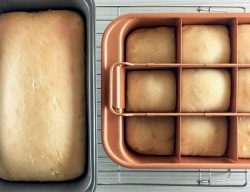
Potato Flake Amish Friendship Bread
Ingredients
- 1 cup Potato Flake Amish Friendship Bread Starter
- 6 cups bread flour plus extra as needed
- 1 tablespoon salt
- ½ cup sugar
- ½ cup oil
- 1¼ cups warm water
Instructions
- Using a stand mixer with a dough hook or in a large bowl, add starter, flour, salt, sugar, oil, and warm water.
- If using a stand mixer, knead for 5-10 minutes until dough is smooth and elastic. If mixing by hand, knead on a floured surface for 10-12 minutes or until dough is smooth and holds its shape.
- Place in a greased bowl and cover with a damp dish towel. Place in a draft-free area (a microwave or unheated oven works well). Let dough rise at least 12 hours or overnight.
- Punch down and turn dough onto a floured surface. Knead for several minutes to remove any air bubbles.
- Spray 2 loaf pans with cooking spray. Divide dough in half, shape the loaves and place into the pans. Cover and allow the dough to rise until it has doubled in size, about 6-8 hours.
- When ready to bake, preheat oven to 350° F (177° C).
- Bake for 30 to 35 minutes until the tops are golden and the bread has pulled away from the sides of the pan. If desired, brush the tops with butter 5-10 minutes before removing from oven.
- Remove from pans and serve warm.
- ENJOY!
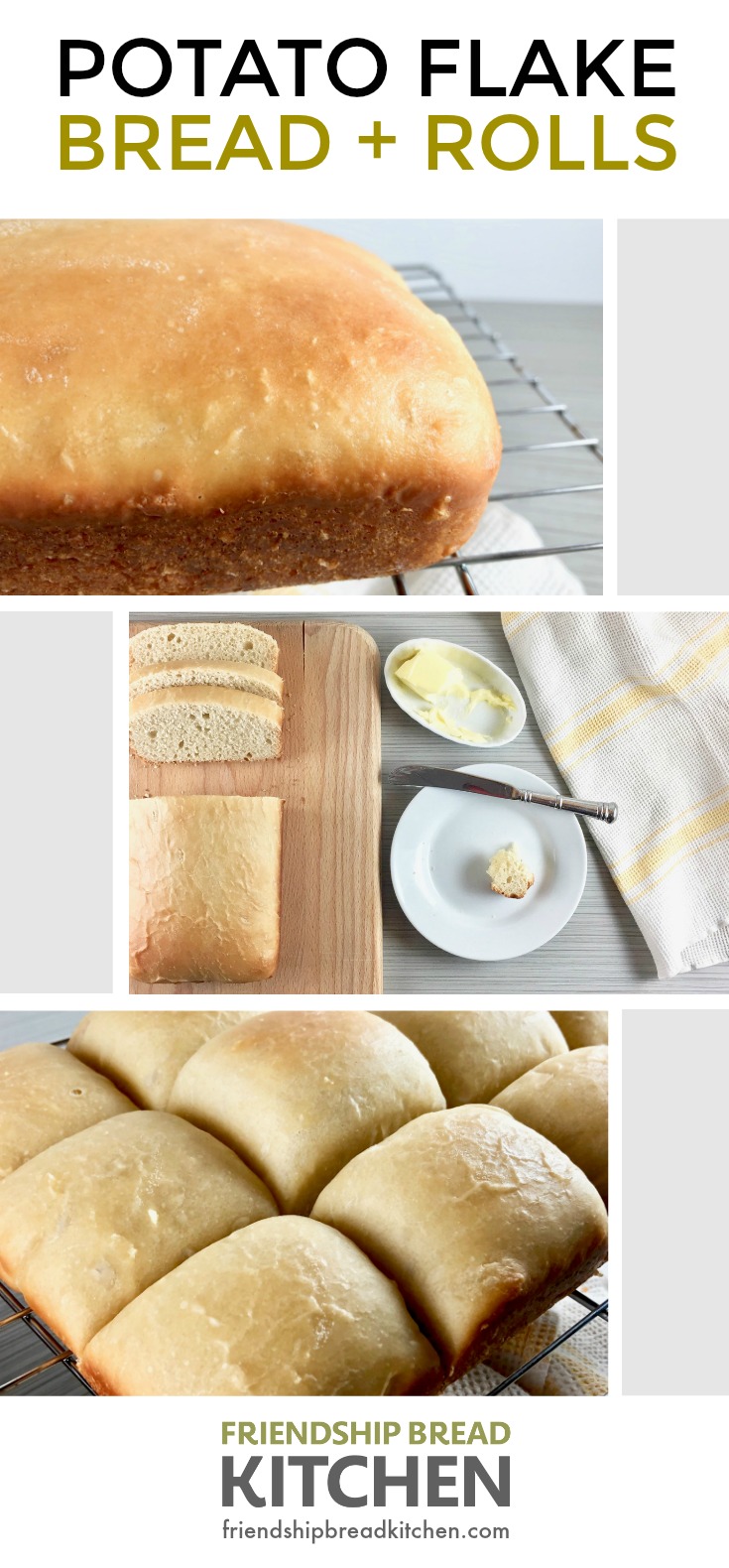
>> Have you tried this? Share your best pic with us or leave a comment below and let us know how it worked for you!
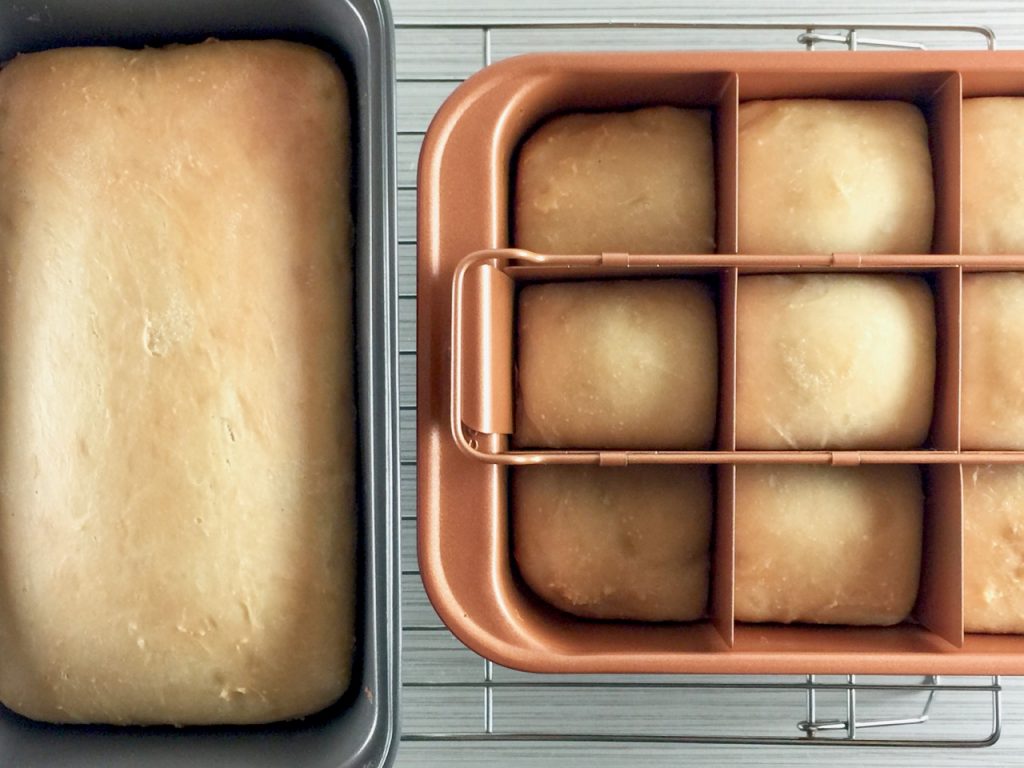
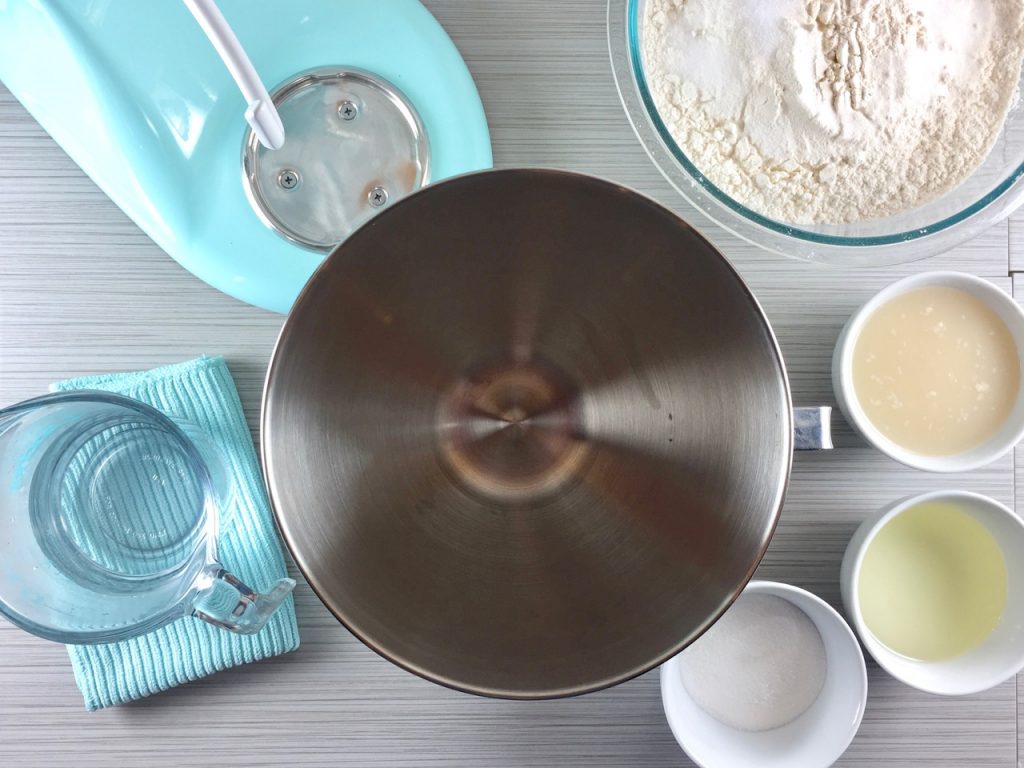
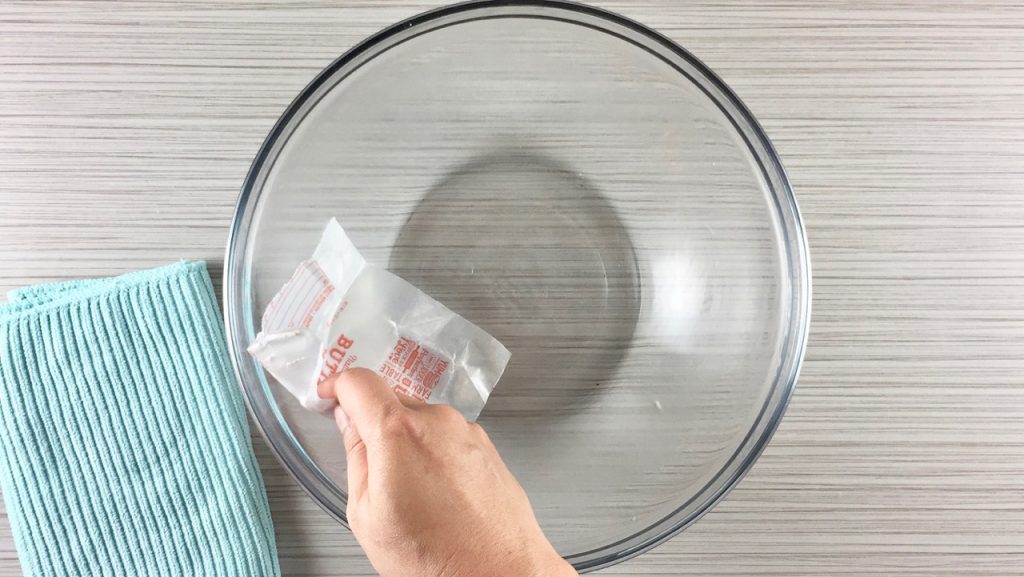
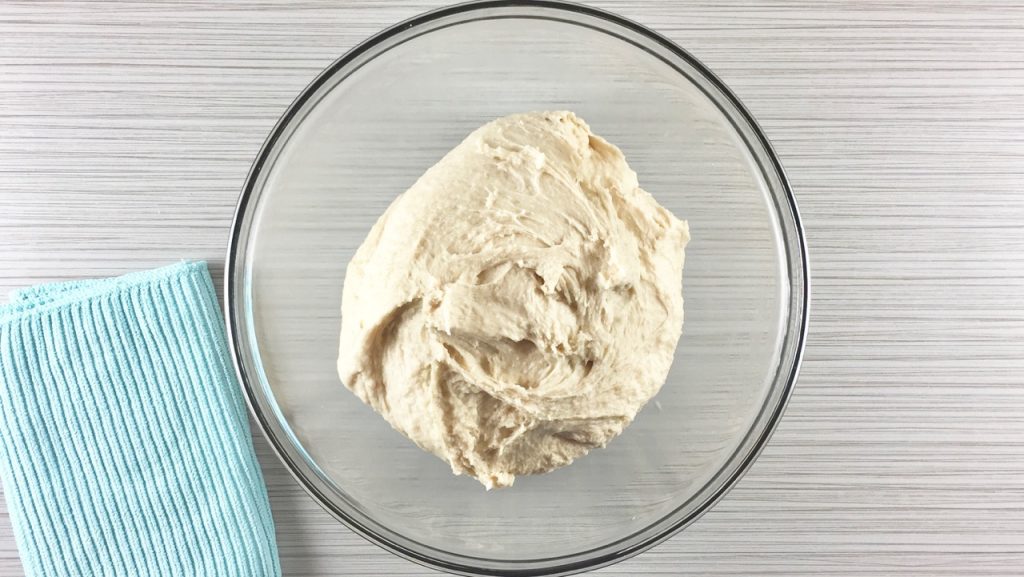
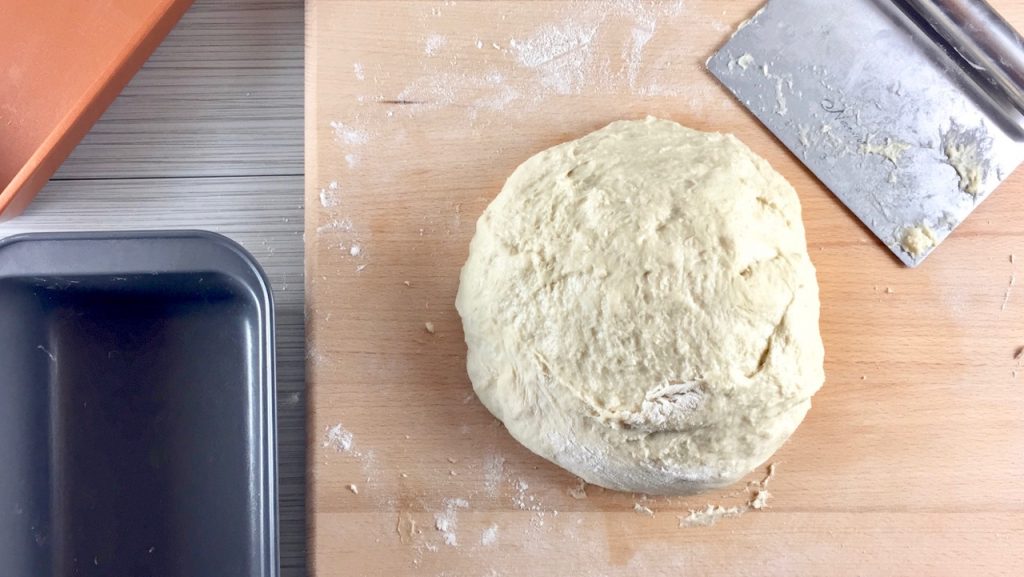
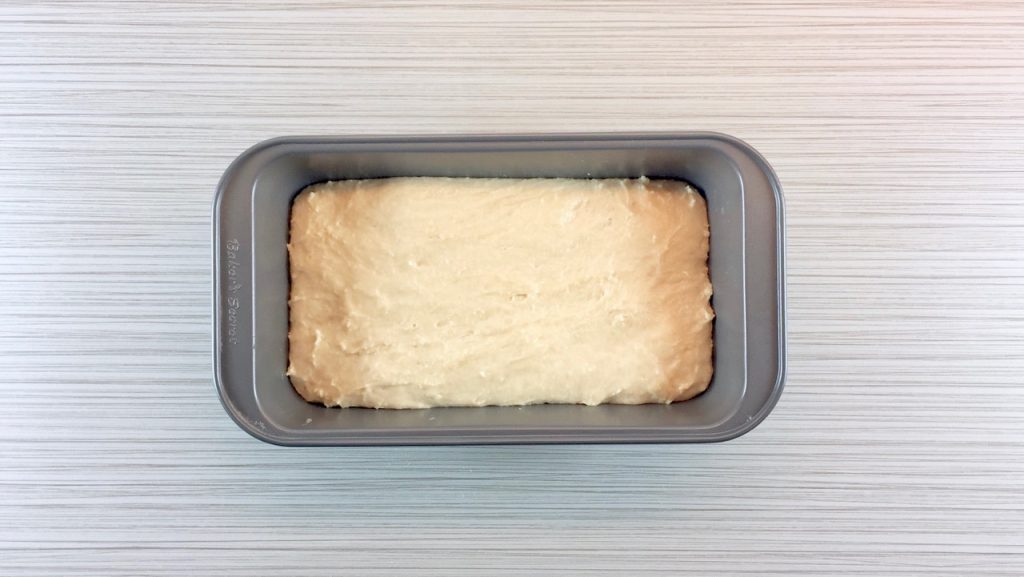
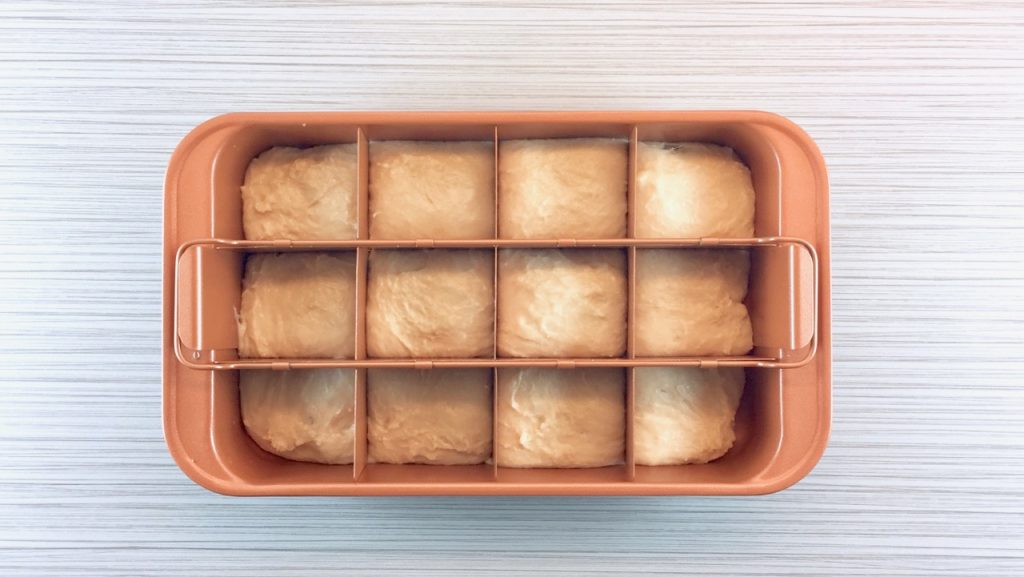
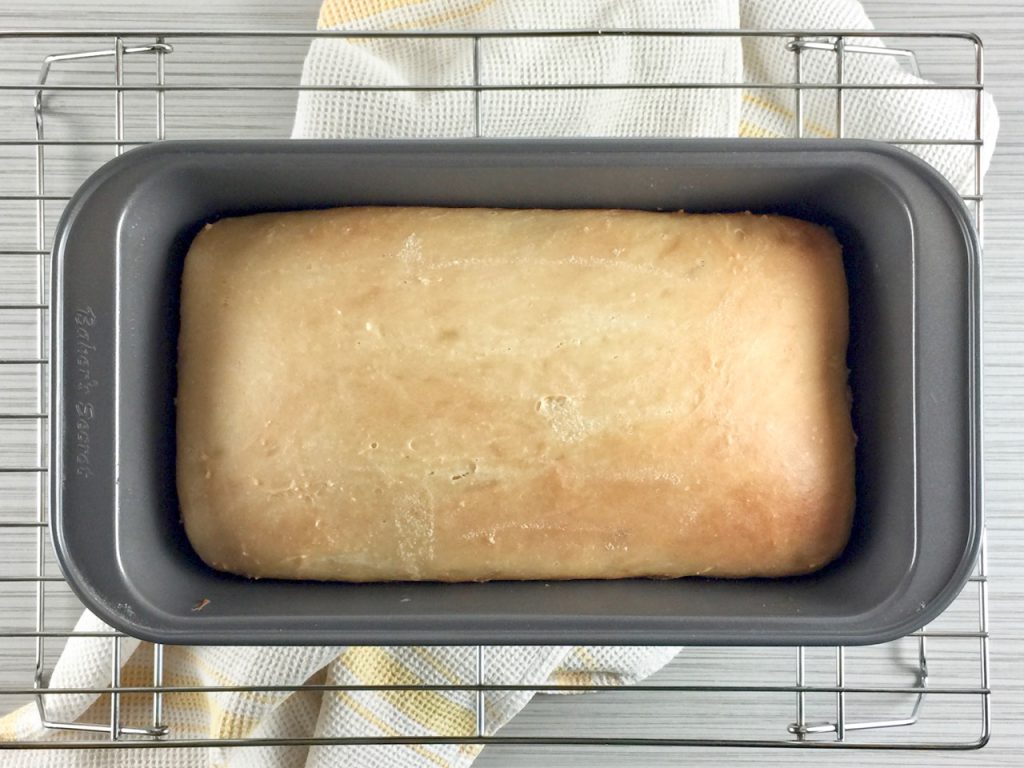
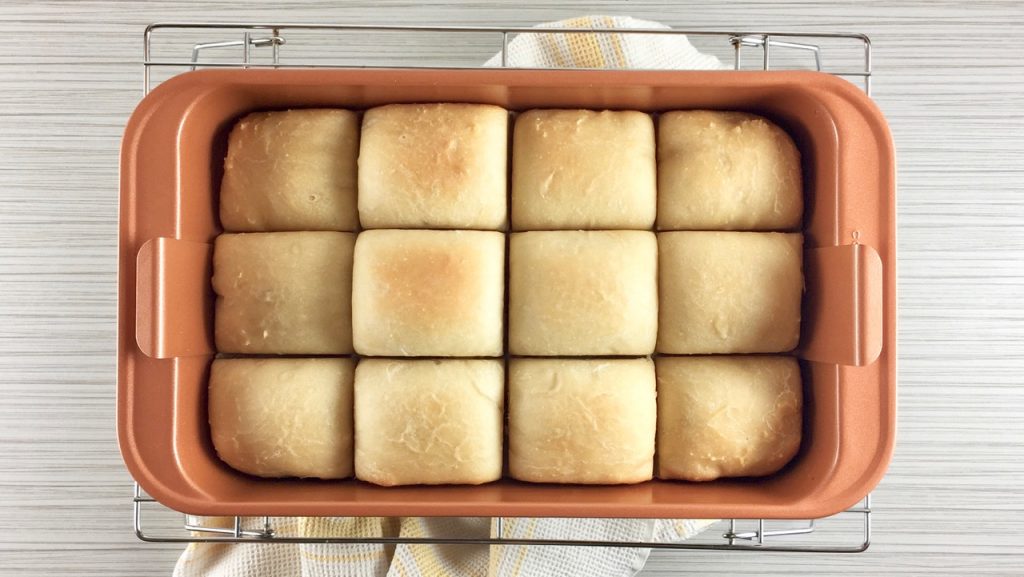
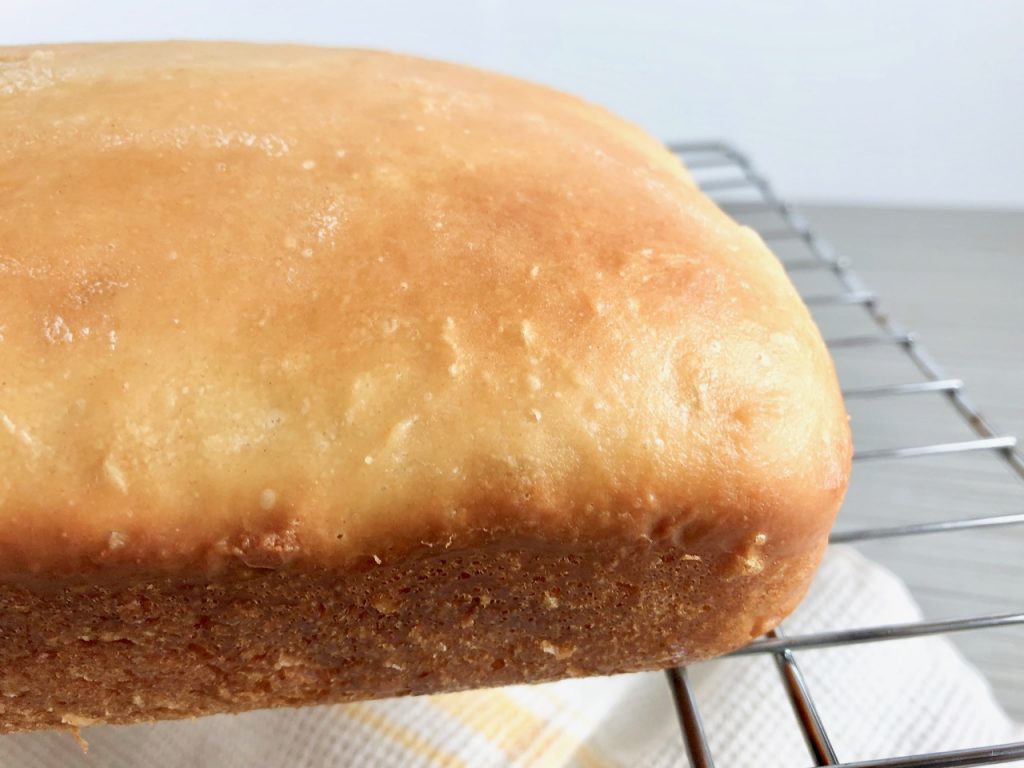
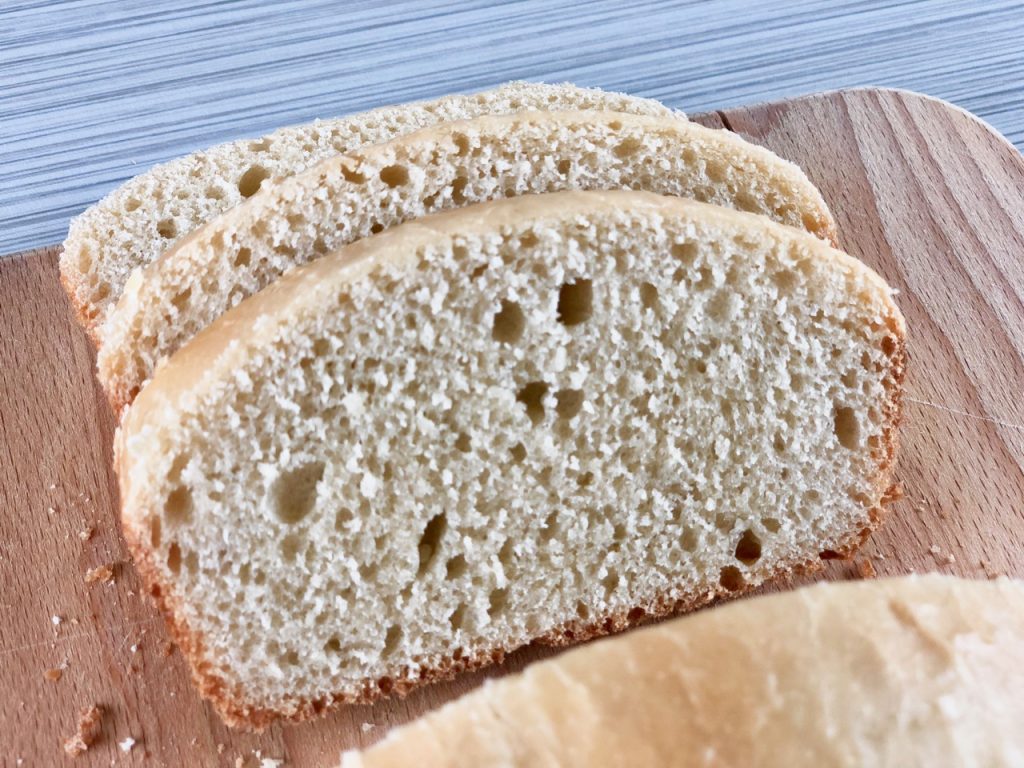
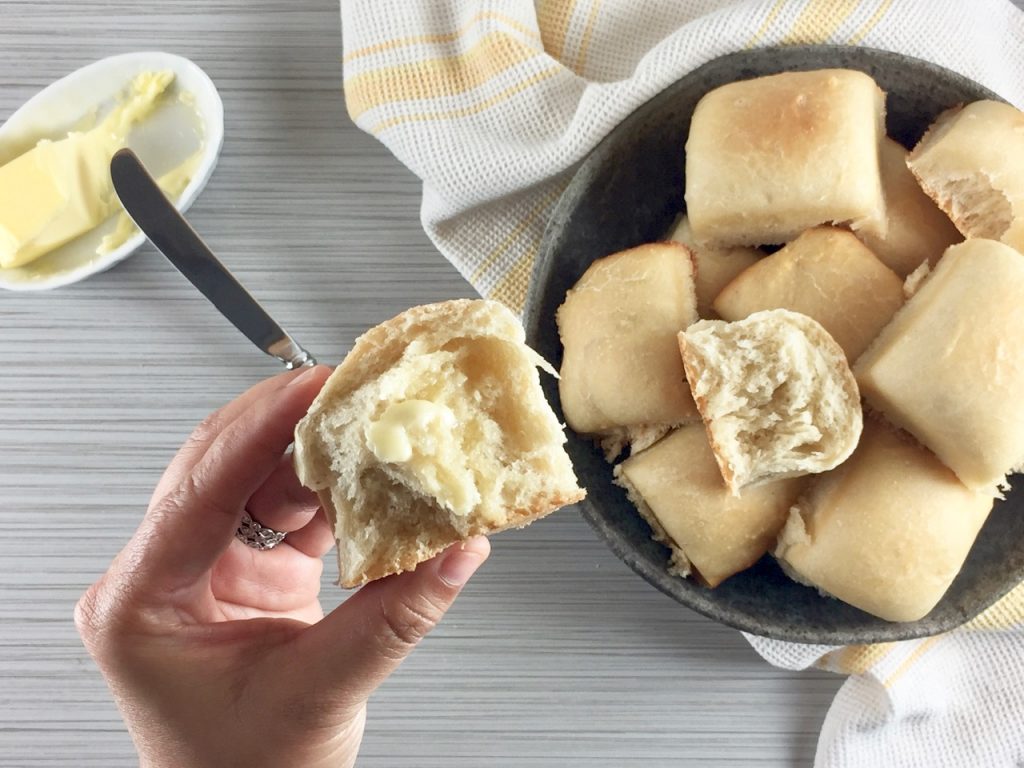
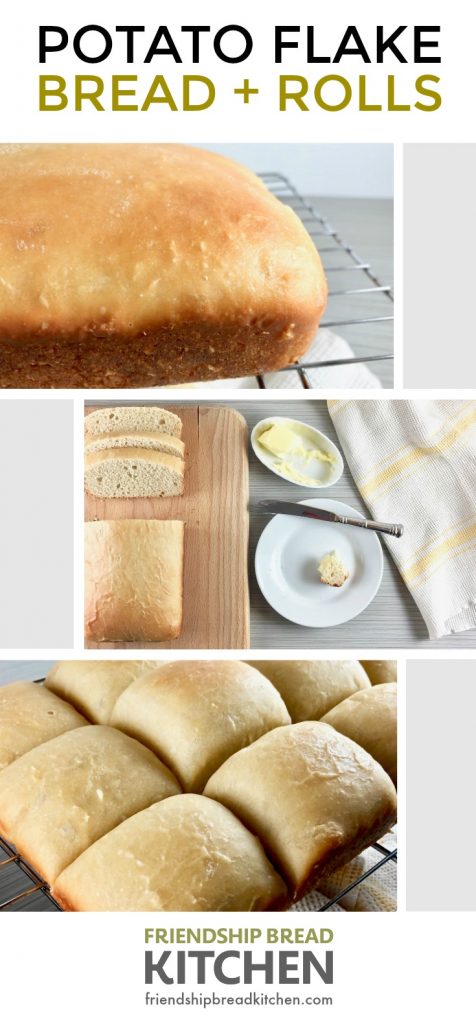
Do I need to feed the starter at 5 days even if I am not ready to bake? Could I wait to feed it at day 7? I really need to bake around the weekend if possible.
Hello has anyone used gluten free flour if so what kind? I used all purpose blend and did not rise .tasted good tho help😊
This recipe will not work with gluten free flour. Gluten is the building block of all traditional bread, it gives it the elasticity and it binds the molecules together giving it that amazing texture. Without it, traditional bread texture does not exist and the bread cannot rise. Your best option is to research gluten free bread recipes, which are more like batter Breads when you make them, but many are quite good. Good luck with your search!
Can you share nutrition information? I need to know carbs for my diabetic grandson for insulin dosage. TYIA
Is this considered to be sourdough bread? And does it have the same gut benefits as regular sourdough bread?
Could you use this recipe for cinnamon rolls?
I love this bread! But have a question. I put my bread in a cold oven to rise. After my bread has risen I turn my oven on and cook. The problem is there’s usually a huge air pocket between the crust and the bread after cooking. How do I fix so that doesn’t happen? What should I do differently?
I have always heated my oven to 190 then shut it off when putting the bread in to rise. That has helped me
What size bread pans for 2 loaves? 1.5 pound?
Thank you
I used this recipe to make my first loaf of sourdough! It was great! I am getting ready to start making mini loaves (half sized) to give away for the holidays. Do I need to adjust the cook time and temperature to do this? I should be able to get 4 mini loaves per mixing.
Can I sub the oil for melted butter instead of oil?
I have subbed butter every time I made it except once. That one time I used canola oil and I threw the bread in the trash because I we didn’t like the flavor. Butter works fine.
How do I store my bread loafs to keep them as fresh the longest.
Thanks for the help.
I am looking forward to trying this bread when my starter is ready.
I do not have bread flour, but I have a lot of plain (A/P) flour.
Has anyone ever used this recipe with plain flour? I’ve seen many other sourdough breads that said using plain flour was fine, but this will be my first time using a potato flakes starter.
I used to make this bread all the time and yes ap flour works great. Some times I would use them both, three cups ap flour and three cups bread flour to save money. Hope this helps.
I did not even look at three date on her post. Hopefully she got her answer. My bad!
If you want to make wheat bread with this recipe how many cups of wheat flour and how many white (regular flour) should you use?
I regularly make this recipe with 50% bread flour and 50% wheat flour. It turns out great.
I see the amount of water differs in the beginning instructions and the recipe. Is it 1-1/4 cups water or 1-1/2 cups water? Thank you.
It’s 1 1/4 cups of water! Thank you for catching that, Sandy!
Hello. I am new to this. I plan on doing the sour dough potato starter. I am going to make it now. But hiw many times during tge 10 days should I feed it? I see you have said that the starter shoukd not have more than 2 cups. Please help me.
Hi Ray! This recipe should help you with making your first Amish Friendship Bread Potato Flake Starter: https://www.friendshipbreadkitchen.com/potato-flake-starter-afb/
Hi, I’ve used this recipe several times & when I bake for 30-35 minutes, the center is not done. I’ve been using my digital thermometer to see if the center is at 190° & uncooked dough is always on the probe. My cooking time is running 45-50 minutes. I have to cover the top when it gets the color I want or the top cooks too dark. Am I doing something wrong?
Hi so glad I found this recipe. I had this starter years ago. My question is:
I have a proof setting on my oven. Can I use it for the final rise?
Hi Kelly! We’ve never tried it with a potato flake starter, so you’ll have to experiment. But in general, it should be fine. Let us know how it goes if you try!
If I feed my starter on Saturday do I have to make my bread on Sunday or can I put my starter in the fridge on make it on Monday or Tuesday?
I am using the potato flake starter.
Thank you.
Hi Elaine! Yes, that should be okay if you bake a little later, just keep in mind the existing starter should not be more than 2 cups — discard or bake with the excess before feeding. You may also want to let your starter sit out of the fridge for a 4-8 hours before you bake with it. Let us know if we can answer any other questions!
THANK YOU
I’ve found that I have a gluten problem and I would like to use gluten free baking flour in it instead of bread flour. Is this possible to do and have a gluten free loaf?
Hi Carla! We haven’t experimented with gluten-free flour for this recipe in particular. However, some people have tried using gluten-free flour mixes with some success. If you try to experiment, we would probably recommend trying the King Arthur gluten free flour. Let us know if you end up trying and how it goes!
How long before you discard a portion of the starter?
Hi Leslie! Our 101 Potato Flake Starter post should help with the feeding and discarding schedule of the starter: https://www.friendshipbreadkitchen.com/101-learn-about-potato-flake-sourdough-starters/ Let us know if you have any other questions!
Can you use different flours with this bread? For example, half whole wheat and half bread flour …and possibly substitute honey for the sugar? Thanks!
Hi Janice! We haven’t tried this recipe with whole wheat flour, so you will have to experiment a little. Here’s a great post about substituting with whole wheat flour: https://www.friendshipbreadkitchen.com/faq-substitute-bake-whole-wheat-flour-for-all-purpose-white-flour/
We haven’t tried substituting with honey in the recipe, either, but you should be able to do a 1:1 substitution with this recipe. However, honey is usually sweeter than sugar, so you may want to reduce the honey amount. Let us know if you have any other questions!
Where can I purchase that Cooper Pan that makes 12 mini loafs.
Hi Valerie! It was bought on Amazon, but unfortunately we haven’t seen it for sale online since! There are copper pans with brownie sized cavities that is in a 12X10 pan: https://www.wayfair.com/kitchen-tabletop/pdp/gotham-steel-non-stick-brooklyn-brownie-baking-sheet-gtst1033.html?piid=
I have a question I was gifted a starter yesterday. It was at day one. I accidentally put it in the refrigowhen I got home .
Read I was suppose to make the bread up so took it out overnight .
Did I kill the starter. Should I make the bread up today
Could use some help
Hi Cyndi! Were you gifted with a potato flake starter or a traditional Amish Friendship Bread starter? Either way, your starter should still be ok! We would recommend feeding it and letting it sit out for 8-12 hours on the counter before you use it to bake with. Does that help?
My first time to make and I am confused about using starter. Some sites or comments say to feed the starter, let it set for 8 hrs then take out a cup to use. Others say take out a cup then feed, let set and then back to fridge. Which is correct or is both OK. Which one is best.
Hi Rita! Most of the recipes on this site are anytime recipes — you can make them anytime during your 10 days after you’ve gone through at least one round of maintenance if you’ve made your starter from scratch. You don’t have to feed before you bake with it! Just feed it as usual on day ten! These will be your quick breads, pancakes, and any recipe that isn’t using the starter to be the main leavening agent.
If a recipe calls for an “active” or “bubbly” starter (usually the more traditional sourdough-type breads like this one, as well), it’ll be indicated as such on the recipe card. This means you will want a really active and recently fed starter. This usually means you should feed your starter within 8-12 hours and leave it out before baking with it! You will also want to see your starter just about double in size after feeding but before using (this many vary slightly with your potato flake starter). Let us know if you have any other questions!
Has anyone tried to make this gluten free? I’d love some tips! Thanks!
I’m a little confused and I did read the post that you referred to several times. That post says to start the process with the new starter, leave out, refrigerate, etc, stir for days 6 and 7, then take out a cup for baking…..and give away or feed the leftovers to start again. But at the beginning of *this* page, you say to make sure you feed the starter the same day you’re going to bake with it. Which is the correct process? And thank you so much😊
Hi LeighAnne,
Every starter and every kitchen is a little different. We have found that this recipe seems to work better after you feed the starter then leave it out for 8-12 hrs. Otherwise, the general rule is that you can take one cup out of your starter straight from the fridge and use it. However, it’s always an experiment to find what works best in your kitchen! Let us know how it goes!
Just my two cents. I feed my starter in a bowl. Let it sit 8 plus hours on the counter. I then take out one cup and make my dough In a large ceramic bowl and put remaining starter back in my jar in the fridge. I mix my dough very sticky, usually have to add a little extra hot water to get it there. Dry dough will not rise. Spray the top with oil and cover the bowl with plastic wrap. I put my dough in our garage. It is very warm there and let it rise to double – usually over night
Then I pour the dough out in a single blob on a floured surface. Sprinkle generously with flour and knead 6 or 7 times total. Mine is very elastic
Put in loaf pans and let rise to double. Back to my very warm garage. 8-12 hours but watch it. If it over rises it will collapse during baking. It should not rise to a giant mushroom.
Good luck. I get 2 large and one small loaf every time
Thanks for your insight, Karen!
My family loves this bread and recently I used it to make hamburger buns and hot dog buns!! Yummy!
So glad these turned out for you, Linda! If you took any pictures, we’d love to see them, as well! Feel free to post them on our group Facebook page: https://www.facebook.com/groups/amishfriendshipbread
I had the same question as Nancy #43. I think we need to know these steps exactly. Thank you so much!!!
There’s a full post here that should help, Cindy: https://www.friendshipbreadkitchen.com/101-learn-about-potato-flake-sourdough-starters/. 🙂
Regarding the Potato Flak starter and the Friendship bread starter, are they interchangeable within all the recipes on this site?
Thanks
Hi Kari! If you are wanting to use your potato flake starter with other AFB recipes, you will have to experiment. Because they are different types of starter they do react differently in different recipes. Happy baking!
Do you add the starter to the recipe from the refrigerator cold or do you feed it and let it sit at room temperature for 8-12 hours before adding it to the recipe? Thanks!
Hi Kari! For this recipe, we’ve found that it works better when you feed your starter and let it sit out for 8-12 hours before using!
Hello Darien – My question is regarding the timing of the feeding before making the bread. Do you refrigerate for 3-5 days, feed the starter, then make the bread 8-12 hours after feeding?
Hi Nancy! It takes almost 8 days. This post should help: https://www.friendshipbreadkitchen.com/101-learn-about-potato-flake-sourdough-starters/
This bread is delicious, but very sweet! Would it ruin the rise if I took out the sugar?
Hi Kaitlyn — You can definitely reduce the amount of sugar (I wouldn’t exclude all of it) if you’d like a less sweet version!
Where did you get your copper buns pan? I’d love to order one.
I don’t know if they are still selling the copper bun pan I have on amazon, but these brownie pans should do the trick, too.
Yesterday I feed my bread and put it back in the fridge after 12hrs. My question is will it be ok to take 1 cup out today let it sit a few hours to get to room temp then start the bread making process?
Hi Shae! Yes, that should be fine!
I have not made sourdough bread yet, but I do like it, so I would try this recipe.
My mother made this bread for us when we were growing up. I just got starter from a friend of hers and have baked it 3 times now. Here are my questions…1.my bread is not rising as well as I remember my mother’s…once I divide it into the bread pans. Any thoughts?
2. My bread is dryer than my moms. Any solutions for this?
3. The top of my bread isn’t at smooth and pretty as the pic above…i remember my mother’s always looked lovely and her friend from whom I just got the starter is smooth. I was afraid to over knead the dough.
Thank you for your help!
I found that kneading my dough 8-10 minutes after mixing ingredients together was way to much, ( my dough didn’t rise at all) I started just making sure all ingredients were mixed well ( started out stirring with a wooden spoon just to get it somewhat together then used my hands to finish) only takes about 4-5 minutes to get it all together. Then on second rise I just knead about 2 minutes and place in pans for second rise.
This one looks like a winner. I will make this with a hearty stew. I will end up with one happy hubby.
Sorry I meant to say…
Even when I use less flour , not dough.
And on the 2nd rise, don’t use a wet towel, if you use one, just a dry towel .
Great tips, Tami … thanks for sharing! 🙂
I think the recipe is spot on. Properly measure 6 cups of bread flour. I noticed when I used the wet towel on the first rise that it really compacted the dough and made it denser. I didn’t like using it in the 2nd rise because it wasn’t as fluffy. I like some air left in it I guess? But if you are using the stand mixer with the dough hook, you really don’t have to touch the dough. I just use a spatula, and scrape it into the greased bowl. But definitely using the 6 cups of flour and the wet towel helped my dough a lot!
I do sprinkle in a little flour after I split the dough in half & knead it before the 2nd rise. But it doesn’t need a lot. It’s going to be sticky a dough, but even when I used less dough & over mixed it, or let it rise too long, no matter what I did to it it still comes out tasting great!
So glad it worked out for you, Tami!
I have tried this about ten times now. Fail each time. Starter from the Potato Flake Starter. It will not make a ball as it’s so wet and recently not been rising much either. Bread is very dense and not fluffy like my moms used to be. I am looking for someone to text, email or talk me through this. I grew up on this bread and my son always loved his meamaw’s bread. Please help!
Hi Debbie! I’m not sure what’s happening with your bread or starter — we make this regularly. Are you trying it each time from the same starter, or are you making a new starter from scratch? It’s important to see the activity and also keep an eye on your kitchen. What part of the country do you live in (as the temperature in your kitchen can affect rising)? Did your mom make the bread from a starter, or did she have a different potato bread recipe?
Hi. The last three attempts have been from the same starter. Our house temperature is set at 76 or 77 degrees. I bring starter out of refrigerator and feed. I have left it for 8hrs and on other starters for as long as 24hrs. Both ways I have seen it foam up and rise up from bottom to the top. Yes my mom used the potato flake starter as well. I am mixing and kneading in the KitchenAid with dough hook. If it’s possible to text on FB or regular texting would be helpful.
Hi Debbie! I’m going to email you directly. 🙂
Hi, can you tell me how often you feed your starter? Is it every 5 days? I made a bread like this years ago, but it seemed like you fed it every 3 days?
Thank you! I am so thankful to have found your site! A dear friend gave me this exact recipe years ago and I used it a lot back then, but I just came back to it after 20 +years and my bread has been turning out ok, but I really wondered if I was remembering it right. My dough can be so finicky! This is the first time that I have found the exact recipe that I have PLUS you use a dough hook too! I am doing that for the first time and I may have been using it for too long. My favorite recipe from years ago was to make cinnamon rolls and I hope to start that again as well! This starter creates THE BEST!
Thank you for sharing your skills and I so look forward to learning more! I am off to buy that copper divider set too! Bless you !
I’d like to make this for my B-I-L but he has a bad case of Celiac disease. This recipe calls for bread flour so I need a way to make it totally gluten-free. How do I do this?
HI Candice! We haven’t tried this recipe with GF flour before, but this post may help guide you if you’d like to experiment: https://www.foodnetwork.com/healthy/packages/healthy-every-week/healthy-tips/best-gluten-free-flours
Good luck!
Have you ever tried to make this gluten free?
Hi Amanda! We haven’t tried it with a GF flour alternative before. If you do end up making it, we’d love to know how it goes, though!
Yes, I would like to make this too but need the measurements.
The recipe post above should have everything you need, Sylvia! Try refreshing your browser and thanks for letting me know!
I am having the same problem. I need the exact amount of the sugar and potato flakes. I am guessing that you use 1Tablespoon of the yeast. Pat
Is your copper divider pan an 8.5 x 13? Can you tell me what kind of pan it is and where to buy it? Thanks for a great post!
Hi Mary! You’re welcome! My pan is 7″ x 11″ (baking area). I bought it at Target on sale ages ago and you can get it on Amazon here. If that seems pricey, try these brownie pans should do the trick. Happy holidays!
Hello! I’ve made this bread a few times but am always surprised how sticky the dough is. When I knead it before shaping it into loaves, it sucks my hands inside the dough. ? Is that normal or should I be adding a bit of flour to the first kneading/mixing step to ensure a more ball like dough? (I’d consider it more batter-like than dough)
David, I separate it into loaves (blobs) and knead each blob 8-10 turns on a floured surface to get it less sticky. I don’t work it for long, just enough to work a little flour in.
I just started this recipe this morning and am very excited to try the results. However, my dough never pulled away from the sides of the bowl when kneading in the stand mixer. It was very sticky but was smooth. It was elastic but broke apart if I tried to stretch it. I tried the window pane test but it would fall apart instead of staying together. I’m concerned I didn’t develop the gluten enough *BUT* i kneaded it in the machine for like 12-13 minutes. So I stopped for fear of overkneading. Any advice on what the dough is meant to look like after kneading? Should I have kept going or stopped earlier? Who knew bread making was such a delicate dance?!
Hi Christie! It is a delicate dance, isn’t it? Sorry I couldn’t reply in the moment — I’d love to hear how the bread turned out. I think it is a little forgiving — the trick here is to make sure your starter is in good shape (active) as that’s what makes the magic. Hope it worked well for you in the end!
Do you use bread flour or AP/SR flour?
Hi Hope! Bread flour for this recipe!
Any ideas why my bread was rising for about 2 good batches and now the bread is no longer getting a good rise?
Hi Ashley! You have to get the timing right with sourdough starters, meaning that you need to feed it on time and also bake within 8 hours of feeding. Unlike the regular Amish Friendship Bread starter that we feature on the site, this one requires refrigeration and constant attention. You also have to maintain your starter by, sadly, discarding or giving away all but one cup. If you try to maintain a starter with more than one cup in the bowl, the ratio of yeast and sugars are thrown off. Hope this helps!
During the 5 days in the refrigerator, do you stir it each day?
Hi Kim — Yes!
This bread is delicious but it is a time commitment. You really have to plan a day (or two) to make this bread. I have made this in loaf pans, a round cake pan and in muffin tins. All delicious!
Great recipe, my new favorite!
l would like to know if there is a quicker way to do the bread and can you knead it with a stand mixer!
There isn’t a quicker way to make it. However, you can use a stand mixer. I’ve. When making this for years and I use a bread hooks. Have fun!
Can I make a larger loaf or pan free loaf of this bread? Only have one loaf pan .
If I make a larger loaf how should I increase cooking time?
Hi Sandy! It’s a hassle, but we’d probably recommend cooking the bread separately if you only have one loaf pan. It would probably rise to much if you tried to put all the dough in one pan. We haven’t tried a pan free loaf with this recipe, but you could definitely experiment with that. Good luck!
Ooh I loved this one! My husband LOVES sourdough bread and I love potato bread. 🙂
I first tried this bread at my MIL house and it was so delicious! However, if you are not accustomed to making breads, it could possibly be a little tricky to make it. However, do the research, pratice, and you’ll eventually get it.
I agree, Cameron! Classic bread baking takes a little more work, but so worth it. Great advice!
Thanks!